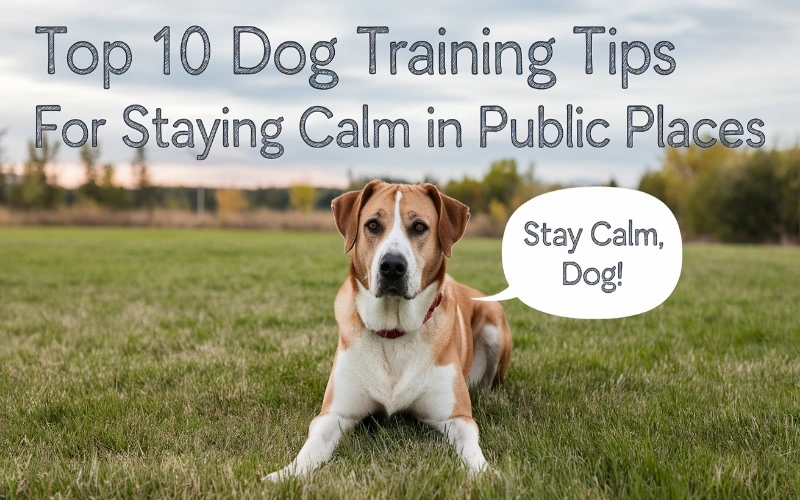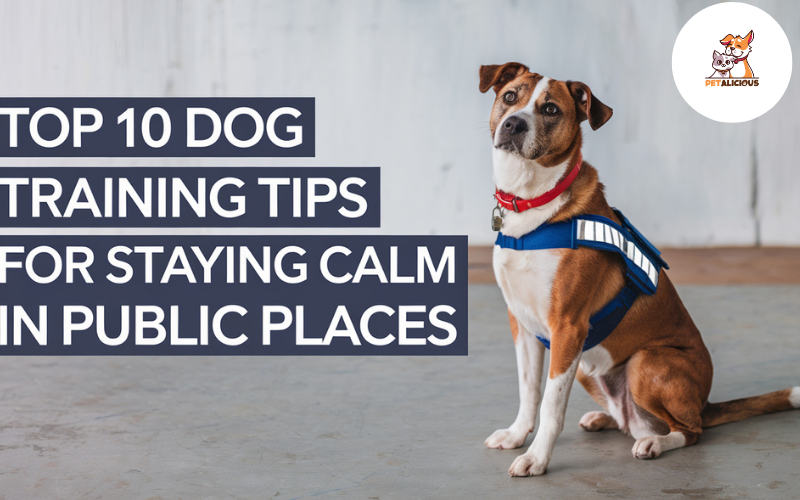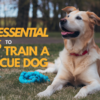Top 10 Dog Training Tips for Staying Calm in Public Places
Going out in public with your dog can and should be an enjoyable and low-stress experience. But dogs who have anxiety, become overstimulated, or get overexcited can make going out very difficult. Whether to the park, a pet store that welcomes pets or a busy street, good training will help your dog stay calm and polite. In this guide, we will explore 10 dog training tips approved by expert trainers to help your dog be calm in public places. These strategies hire effective reinforcement, desensitization, slow exposure, and steady exercise to assist your dog in experiencing comfort and assurance outside the home.
Going out in public with your dog can be a a laugh journey, but it is able to also prove tough while your hairy friend will become overly nerve-racking, distracted, or excited. From packed parks to busy streets, preserving your dog’s composure is crucial to their safety and your peace of mind.
Why Public Calmness Matters
There are new sights, sounds, and smells everywhere in public spaces that can distract even the most well-trained dog. 10 tips for Training your dogs to relax not only makes it more enjoyable. But can also be prevented by Negative encounters and potential accidents with other dogs and other people.
Plus, a calm dog is easier to manage and builds positive experiences in public settings.
Why Train Your Dog to Remain Calm in Public?
Dog training; Dog training goes beyond obedience and following commands. It instills good behavior that also enriches the dog’s well-being.”
Some of the advantages of a calm dog include:
- Sensitive to the ability to safely navigate situations, and avoid risk of accidents and conflicts.
- The possibility of enjoying social interactions more, reducing anxiety, and opening up to better interactions with humans and other beings.
- A level of confidence that makes them feel confident and empowered by being relaxed.
The 10 Tips on How to Train Your Dog To Be Calm in Public

1. Start Socialization Early
Socialization will help your dog feel comfortable in different areas. You want to expose puppies to varying sights, sounds, and people early, but even older dogs can benefit from gradual exposure.
One of the best ways you can do to ensure your dog feels comfortable in public is to properly socialize them at an early age. Accustom them slowly to various environments, people,e and other dogs, in controlled circumstances.
Why It Works: The earlier your dog gets to experience the new world the less fearful and anxious they will be and the more likely they are to adapt with confidence to new situations.
How to Socialize Your Dog:
- Short walks in low-traffic areas in advance of visiting busy places.
- Introduce your dog to people of different ages, including children and seniors.
- Introduce them to other dogs in a controlled setting.
- Use treats and praise to reward calm behavior.
Real-Life Story:
Sarah adopted a rescue dog named Max, who was fearful of new places. She started by taking Max to quiet parks, rewarding him for calm behavior. Over time, Max gained confidence and was able to handle busier environments without stress.
Sarah rescued a dog named Max, who was afraid of new places. She started by bringing Max to quiet parks, rewarding him for calm behavior. As time passed, Max became more and more confident and the busier the environment, the more relaxed Max would be.
2. Use Positive Reinforcement
Positive reinforcement works better than punishment to train dogs. However, you should reward good behavior so that they associate calmness with good experiences.
We can understand how distressing it is when your dog misbehaves in public trust us, we’ve been in the boat with you! Our final piece of advice, difficult as it may be, is to stay as calm and positive as you possibly can. As I’ve discussed previously, your dog can pick up how you’re all tied up inside and stressed about things, which makes them feel like there’s something to be stressed about.
Training Tips:

- Reward your dog with treats, verbal praise, or pats when it stays calm.
- When they keep commands, use a happy, encouraging tone.
- Don’t yell at or punish anxious behavior it can set things back.
3. Teach Basic Commands
Commands such as sit, stay, and leave are critical for keeping your dog under control in public places. Make sure your dog has a solid knowledge of basic obedience training before taking them out in public. This will prepare them to respond to various situations with a cool head. Focus on the following key commands:
How to Train Basic Commands:
- Sit: Hold a treat over your dog’s nose and move it backward. When they sit, reward them.
- Stay: Tell your dog to sit, raise your hand, and say “Stay.” Reward them for waiting.
- Leave it: You put a treat on the ground and cover it. When your dog gives up trying to get it, give them another treat.
4. At-Home Training
You can start to 10 Dog Training Tips that calm behavior in public starts at home. As strange as it sounds, put your dog’s leash in the house and sit next to their bed or a blanket. If your dog lies down on the bed or sits and does not pull on the lead bark or do anything to attract your attention, then silently reward him with a small treat.
It encourages them to understand their leash is associated with relaxation and positive reinforcement. For some dogs, it may take a little longer for them to get the hang of it, but once they do this is a solid building block to have when out and about on walks.
5. Reward Good Behavior Outside

If your dog is walking with you on a leash, and not pulling toward other dogs or people (or barking), reward good or relaxed behavior with a treat just as you would at home. If your dog is not interested in being food-motivated, you can give them their best toys to carry instead or simply distract them with it.
At times, simply providing a treat for your dog to sniff is all it takes to divert him/her. And don’t neglect to shower on the praise as well. Just don’t forget to keep them close at your side while leash-training them.
6. Exercise Your Dog Regularly
Providing your dog with the opportunity to let loose allows them to get behind people, which is why an exercised dog is a calmer dog in society. Dogs who are not exercised much tend to be bored, fired up, and frustrated. Play with your dog daily by throwing the ball, playing with chew toys, or doing whatever exercises you and your dog enjoy.
A tired dog is a calm dog. Before heading to a public place, ensure your dog has burned off excess energy.
Exercise Ideas:
- A long walk or jog before going out.
- Playing fetch or tug-of-war.
- Mental stimulation with puzzle toys.
7. Act Silly
This next one can also sound a touch weird however hear us out. This technique is called the “jolly ordinary”, and it’s frequently used to assist apprehensive or nerve-racking puppies not to sense tense or nervousness in public. For instance, if considered one of your canine’s triggers is other dogs, wait until you notice some other dog coming near while you’re out strolling.
Relax your body (this enables your dog to relax), talk to your dog in a “baby voice”, smile, laugh, and maintain your body language open and friendly. This suggests to you 10 Dog Training Tips that there’s not anything to be frightened of. You may feel like a bit of a buffoon doing this in public, but hey, it can be work.
8. Create a Calm Routine Before Going Out

Before heading to a public location, have interaction your dog in calming activities like an extended walk or a short play session. A properly-exercised dog is less probable to be overly excitable.
Why It Works: Burning off excess energy allows your dog to stay composed in new environments.
Calming strategies can assist your dog loosen up in overwhelming conditions.
Effective Methods:
- Deep stress remedy (gently placing a hand on their chest).
- Using calming pheromone sprays.
- Teaching a “settle” command to encourage relaxation.
9. Go to Obedience Classes
If you’re having a tough time getting your dog to loosen up when out in public, it is probably really worth giving obedience 10 tips for Dog Training. These are run using people who understand the satisfactory methods for maintaining puppies as calm and relaxed as feasible and the sessions supply your dog a chance to be around different dogs in a non-threatening, controlled environment.
If you’re concerned approximately your dog acting out, don’t forget that dog obedience training has visible it all before and will be able to educate you some worthwhile techniques.
10. Pick a Quiet Time
When just starting, it’s now not a pleasant concept to take your dog out after they’re all overrated or to a place in which there’ll be quite a few people or different dogs especially if your dog is the apprehensive type.
Wait until your dog is in a relaxed mood and has been to the restroom earlier than on foot. Start exceptionally and slowly and go to nearby calm places. This way, you furthermore might have the peace of thoughts that home isn’t far away if your canine begins to stress out.
Common Challenges and Solutions

Overexcitement: Use a leash and command like “sit” to redirect your dog’s focus.
Fearful Reactions: Start with low-stimulation environments and gradually increase exposure.
Pulling on the Leash: Switch to a no-pull harness and practice loose-leash walking techniques.
Easy Ways to Stop Your Dog from Jumping
🐾 Sarah Lee has worked with dogs of all breeds and temperaments, helping pet owners train their furry companions to stay calm in various environments. With over eight years of hands-on experience in canine behavior, Sarah specializes in positive reinforcement techniques that build confidence and obedience in dogs.
🐾 Her dog, Max, once struggled with overstimulation in public places. Through structured training and consistency, she transformed him into a well-mannered companion. Sarah’s expertise ensures that every tip in this guide is practical, effective, and based on real-world training success.
Written by Sarah Lee, a Certified Canine Behaviorist, with 8+ years of experience.
Additional Tips for Public Outings
- Know Your Dog’s Limits: If your dog shows signs of stress or fatigue, it’s okay to cut the outing short.
- Plan: Choose dog-friendly locations and avoid peak times to reduce stress for both of you.
- Stay Consistent: Regular practice and reinforcement are key to long-term success.
Final Thoughts
By the use of these 10 training tips, you could assist your dog in experiencing extra confident and comfort in public places. Whether you’re at a café, a park, or a bustling avenue, proper training will make outings exciting for each of you and your pup.
Remember, each dog is exclusive. Some might also need extra time and patience, but with the right strategies and consistency, you’ll soon have a calm and properly behaved partner geared up to explore the arena with you.
- How to Stop Your Dog From Jumping on People: 10 Effective Methods
- The 12 Most Common Dog Training Mistakes and Their Solutions
- Why Every Pet or Beagle Owner Should Have Pet Insurance
FAQS
Training time varies depending on your dog’s temperament and experience. Some dogs may adapt within a few weeks, while others may take months of consistent practice.
If your dog shows signs of extreme anxiety, start with short, positive outings and gradually increase exposure. Consider working with a professional trainer or veterinarian for additional support.
Some breeds, like herding or guardian dogs, maybe more reactive in public due to their instincts. However, any dog can learn to stay calm with proper training.
It’s never too late! Older dogs can learn new behaviors, but they may require more patience and consistency compared to puppies.
Start with less crowded places and gradually expose your dog to busier environments while rewarding calm behavior.




